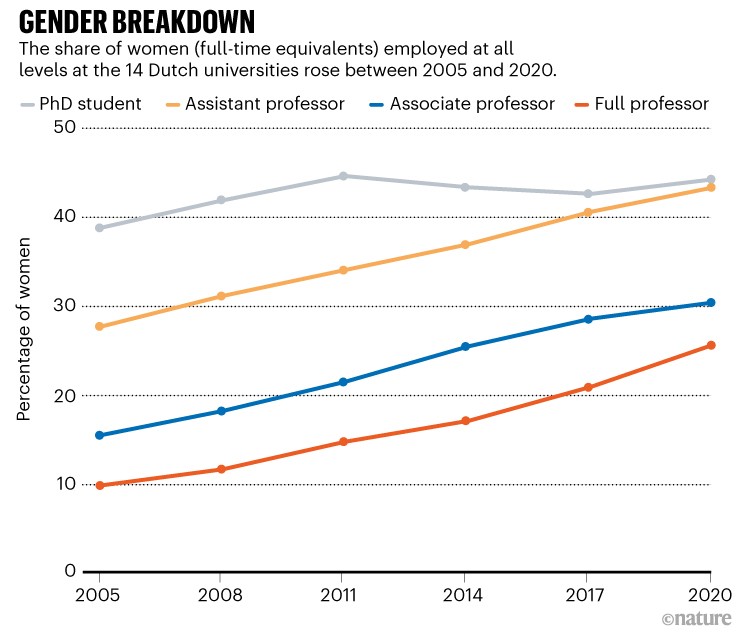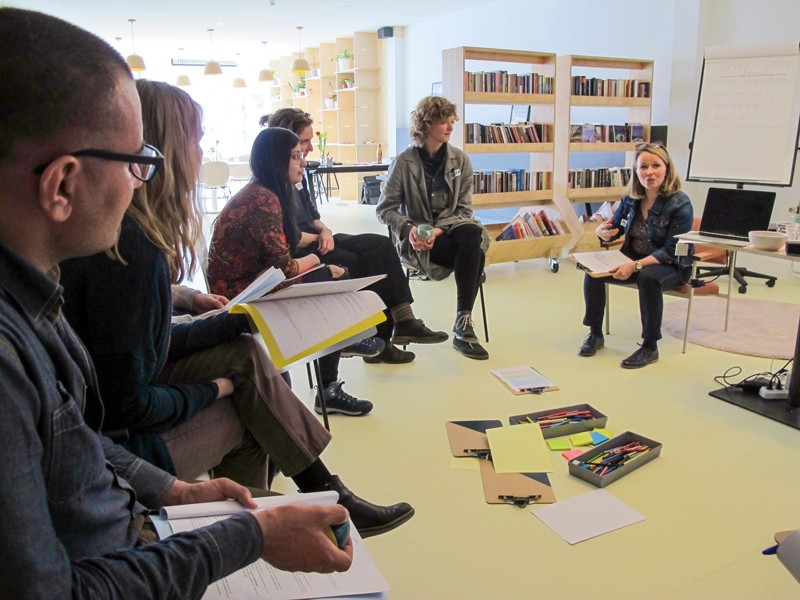Academic success is still defined mainly by publishing lots of articles in high-impact journals and landing prestigious grants. These measures privilege one type of academic profile and skill set. They fetishize the ‘lone scholar’ and obscure the crucial contributions of teamwork and good leadership.
There is growing awareness that current measures of good scholarship are sorely insufficient, or even inappropriate, to assess a diverse population of academics and academic roles. Important impacts that are mostly hidden include mentorship and leadership, teaching, academic citizenship (the work done outside normal teaching and research, often to support a university’s civic mission) and societal engagement.
In 2019, a position paper called ‘Room for everyone’s talent’ was published by five academic organizations: Universities of the Netherlands, the Royal Netherlands Academy of Arts and Sciences, the Netherlands Federation of University Medical Centers, the Dutch Research Council and the Netherlands Organisation for Health Research and Development. The paper called for all Dutch universities to develop recognition and rewards (R&R) policies. It said that these should support diverse skill- and competency-based career paths, recognize both individual and team performance, and value quality over quantity in academic outputs.
Universities were urged to re-examine their current policies and recognize a more diverse array of skills and competencies, career scenarios and work–life balance challenges in scholars’ performance evaluations. They were encouraged to become more inclusive of people who have worked outside academia for a period of time or had other kinds of career break, or whose profiles emphasize outreach, leadership or teaching over publishing and grant acquisition.
But diversifying standards of excellence does not automatically advance diversity. In our view, R&R policies should not only strive for greater diversification of career paths, but also contribute to realizing ‘Gender+’ inclusion and diversity in universities. So we’re looking beyond gender here, and the term Gender+ refers to the idea that people who share a gender are not all the same: gender identity intersects with other social dimensions or characteristics. These include age, race, ethnicity, social class, marital or relationship status, disability, religion and sexual orientation. In other words, there are huge variations among people who identify as women, and these are frequently forgotten when it comes to groups that are already marginalized. What someone needs as a woman might overlap with what she needs as a Black person or a disabled person, for example, but these needs are not the same and there might be tension between them. Gender+ inclusion requires that new R&R policies be designed to foster greater representation so that diverse competences are recognized — but without falling prey to bias, whether conscious or unconscious.
Women and members of minority groups remain grossly under-represented in senior academic positions at Dutch universities, despite many institutional and national initiatives. Consider, for instance, the low proportion of women among Dutch universities’ academic staff (see ‘Gender breakdown’). In 2021, almost 45% of PhD students were women, but women accounted for only 25.7% of full professors. Among the four Dutch technical universities (Delft, Eindhoven, Twente and Wageningen), women accounted for less than 21% of full professors.
There is clearly a ‘leaky pipeline’ problem, especially in the move from assistant professor to associate and full professor. Rather than being unqualified, these women are not having their work and accomplishments recognized and rewarded. Ample research shows that such unequal representation is shaped by biases in assessment of individual performance. Assessment policies and procedures play an influential part in determining the scope for bias, so each Dutch university’s new R&R system provides an opportunity to address inequalities in career development and advancement. Universities that don’t address the leaky pipeline in the design and implementation of a new R&R scheme will miss a valuable opportunity, and could even make the situation worse by increasing the scope for biased assessment.
Beware stereotypes
New R&R policies aim to reduce the emphasis on quantitative assessment measures (the number of publications and an author’s h-index, for example) and increase the weight given to output quality, content, scientific integrity, creativity, contribution to science and society, and scholars’ specific profiles in their respective domains.
A growing number of universities around the world have broadened the definition and assessment of academic success by including much-lauded aspects that defy measurement. Some say this could automatically increase the representation of Gender+ groups that are marginalized in conventional academic systems. For example, it’s been claimed that new R&R policies could make it easier for women to get promoted in a tenure-track system by reducing emphasis on publications and grants — domains in which women are presumed to underperform — and increasing emphasis on (currently less valued) ‘soft skills’, in which women are presumed to perform better. Such beliefs underscore how stereotypes shape our thinking about female scholars’ strengths and weaknesses. This highlights the need to raise awareness about the role of stereotypes (not just of women, but also of mothers, LGBT+ people and so on) and the risks of relying on them.
Serious attention should be paid to how conscious and unconscious beliefs about gender and ethnicity, among other factors, shape awareness and interpretations of individual contributions to a collective unit. Women and scholars from minority ethnic backgrounds are less likely to be given credit for their conventional academic contributions and more likely to be assigned or invited to take on less visible tasks that do not add to the case for promotion, such as serving on committees or mentoring junior colleagues. There is an assumption that if these tasks become more highly valued, workplace equality and promotion opportunities should improve.
A more equal arrangement would both recognize such tasks and regularly rotate them between scholars. That would ensure that everyone gets the same opportunity to focus their time and energy on activities that strengthen their development of the well-rounded academic profile that R&R policies are being developed to acknowledge. In turn, that would improve everyone’s career opportunities.
With qualitative assessment approaches gaining traction in hiring, promotion and funding practices, there’s a need for explicit, defined evaluation criteria that leave less discretion to assessors, to reduce the influence of stereotypes. Furthermore, new methods of evaluation should not mean replacing quantitative with qualitative measures or adding extra criteria for all, but should allow diversification of profiles, built on the strengths of individual scholars.
Recommendations
Diversity and inclusion should take centre stage as these new R&R policies are designed and implemented. Here are some recommendations for how to achieve that:
• Develop explicit and clearly defined criteria for recognizing and assessing both quantity and quality in individual performance and contributions to different collective units (research and teaching teams or departments, for example).
• Broaden the definition of ‘good academic leadership’ to include a wider spectrum of styles and behaviours. Support this by offering programmes that allow current and future academics to recognize and embrace diverse forms of leadership, as well as diverse leadership-development programmes specifically tailored to Gender+ groups.
• Correct for, and ensure, sufficient institutional support (financial, administrative, mentoring, scientific) to enable every academic to thrive.
• Ensure that every assessment or recruiting committee has at least one member trained in the area of Gender+ diversity. This could be accomplished by hiring external experts.
• Require all collective unit directors and managers, as well as members of assessment committees, to complete an unconscious-bias training programme to foster awareness, reflection and behavioural change — not only in moments of academic staff hiring and promotion, but also in the day-to-day professional environment.
• Require assessment committees to report on their decisions. Reports should reflect on all performance-indicator domains and include transparent reasoning on which the assessment outcomes are based, explicitly describing how Gender+ diversity was addressed.
• Align all procedures in recruitment and career-assessment processes and accompanying documents (such as vacancy and recruitment advertisements, recruitment support bureaus, externally performed assessments, talent scouting, prize and award criteria) to correspond with new R&R policies. Ensure awareness of these through a university-wide information campaign.
• Collect data to monitor and regularly evaluate development and implementation of the R&R policy, overseen by an independent committee. This would include documenting conversations with those who leave the university or do not get promoted.
Many academic institutions are moving away from conventional assessment criteria and towards recognizing qualitative factors of success. It is essential to keep in mind that a revised R&R system cannot by itself ensure Gender+ diversity and inclusion. This requires fundamental changes in the academic work culture and environment. Hence, we call on the new R&R systems throughout the Netherlands and internationally to take the next steps to improve diversity and inclusion in academia. We cannot afford to lose any of our talent.










More News
How I fled bombed Aleppo to continue my career in science
Powerful ‘nanopore’ DNA sequencing method tackles proteins too
US funders to tighten oversight of controversial ‘gain-of-function’ research